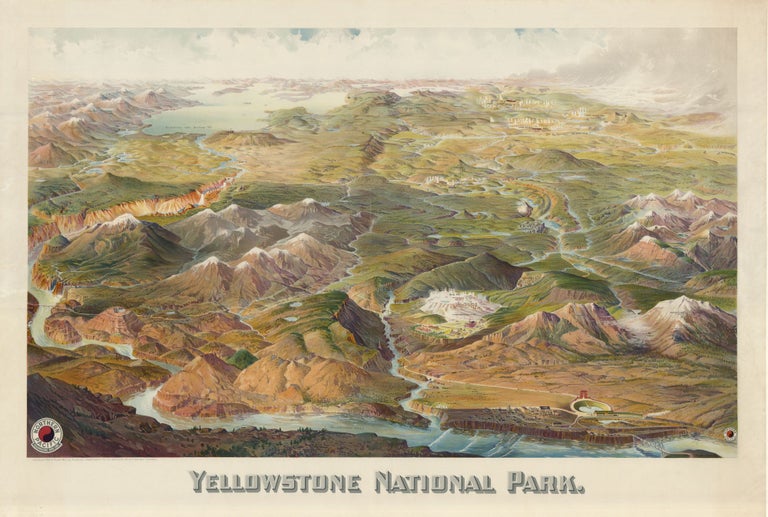Yellowstone National Park.
Milwaukee: Northern Pacific Railroad, 1904. Chromolithograph, 43.125” x 26” plus margins. Recently mounted on linen. A spectacular, richly detailed bird’s eye view of Yellowstone Park designed for the Northern Pacific Railroad by one of the nation’s leading view-makers. This remarkable view—likely the largest of Yellowstone published up to that time—shows the park and vicinity from an imaginary elevated viewpoint in the north looking south. In the foreground are the Yellowstone River, the town of Gardiner, the Northern Pacific railroad station, and the Gardiner Gate to Yellowstone with its attendant reservoir. A multitude of features depicted here have been identified with printed captions, including many mountains both in the foreground and far into the distance, with the elevation given for each. Yellowstone’s numerous geysers can be seen erupting in various locales. Among the many identified features, both natural and man-made, are the Mammoth Hot Springs (and hotel), Obsidian Cliff, the Norris Geyser Basin, the Upper Geyser Basin and the Old Faithful Hotel, the Lower Geyser Basin and the Fountain Hotel, Yellowstone Lake and the Lake Hotel, the Upper and Lower Falls of the Yellowstone River, the Grand Canyon Hotel, the Golden Gate, and so on. Overall, the print offers a marvelous, many-hued impression of one of the great wonders of the American west. Following the publication of the report on the 1870 Washburn-Doane survey of the Yellowstone region, Financier Jay Cooke, whose firm financed the construction of the Northern Pacific Railroad, took an active interest in further exploration of the region, seeing the potential for lucrative tourist travel for the railroad, whose projected route lay just to the north of the future national park. Cooke partially funded Ferdinand Hayden’s 1871 and 1872 explorations of Yellowstone, and loaned $500 to artist Thomas Moran to join the expedition, whose paintings would later serve Cooke’s publicity aims when they were exhibited before audiences in New York. Hayden discovered, as both he and Cooke suspected, that the region’s chief value was as a natural wonder and tourist attraction, as it had little in the way of mineral deposits or timber to exploit. In a letter sent to Hayden late in 1871, Cooke wrote: "Judge Kelley [his friend, Senator William Darrah Kelley of Philadelphia] has made a suggestion which strikes me as being an excellent one, viz: Let Congress pass a bill reserving the Great Geyser Basin as a public park forever…" Yellowstone became a national park when Congress passed the Yellowstone Park Act in 1872. Cooke’s efforts led to the Northern Pacific’s construction of lodges within the park and a robust Yellowstone publicity campaign, inaugurated by Cooke himself, who was known for his ability to draw attention to the projects he funded. The view offered here is easily the most striking Yellowstone advertisement issued by the Northern Pacific, and is arguably the finest view of the park ever published. Henry Wellge (1850-1917), one of America’s most productive and talented bird’s eye view artists, was born in Germany and arrived in Milwaukee around 1878. He soon entered into a partnership with one J. Bach, the two producing three Wisconsin views in 1879, the beginning of a series of thirty-eight lithographs of Wisconsin towns carrying Wellge’s name. In 1880, Wellge began working with J. J. Stoner, who published no less than forty of his views between 1880 and 1884. Wellge subsequently worked with George E. Norris of Brockton, Mass., serving as the firm artist, first in Brockton and then in Milwaukee. Wellge evidently traveled widely in 1884-85, producing views of towns and cities in Florida, Georgia, Alabama, Texas, Tennessee, and Michigan, in addition to more Wisconsin views. In 1888, following Norris’s return east, Wellge established The American Publishing Company, producing some of his most impressive views. One of these, Pikes Peak Panorama (a large ca. 1890 view of Colorado Springs and associated topography) was printed in color and can be seen as a forerunner to the print offered here. Reps credits Wellge with a total of 152 views, published between 1878 and 1910.
This print is quite rare, with just four institutional copies recorded in Worldcat, at Yale, Oxford, the Bibliotheque Nationale, and the Library of Congress. A stunning view of one of America’s greatest natural wonders. REFERENCES: Reps, John. Views and Viewmakers of Urban America, pp. 213-215 (for Wellge biography); The Grand Canyon of the Yellowstone at xroads.virginia.edu. CONDITION: Very good, a few expertly repaired tears to edge of image in margins, trace of a vertical crease through center with a few inconspicuous miniscule losses to printed surface.
Item #6890
Sold


